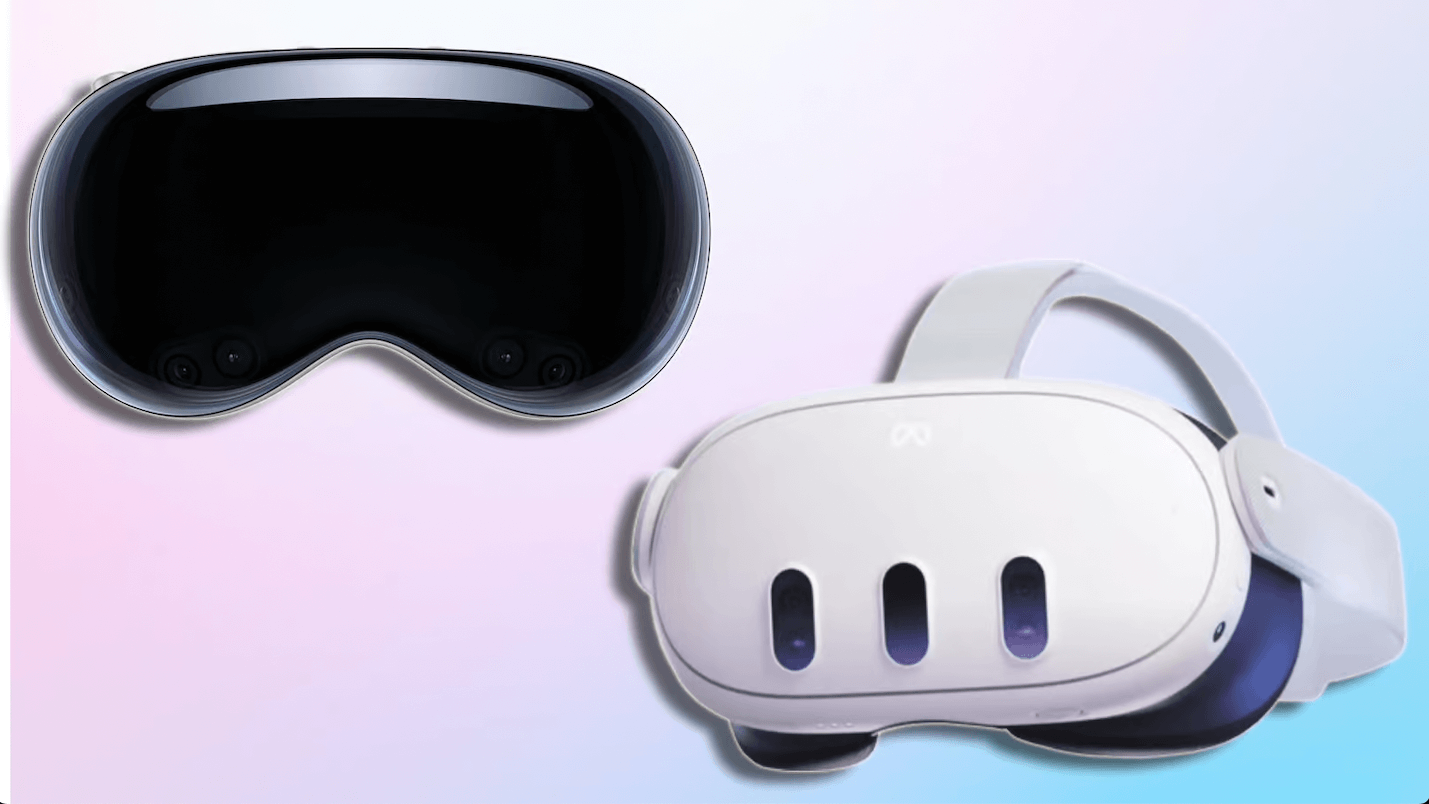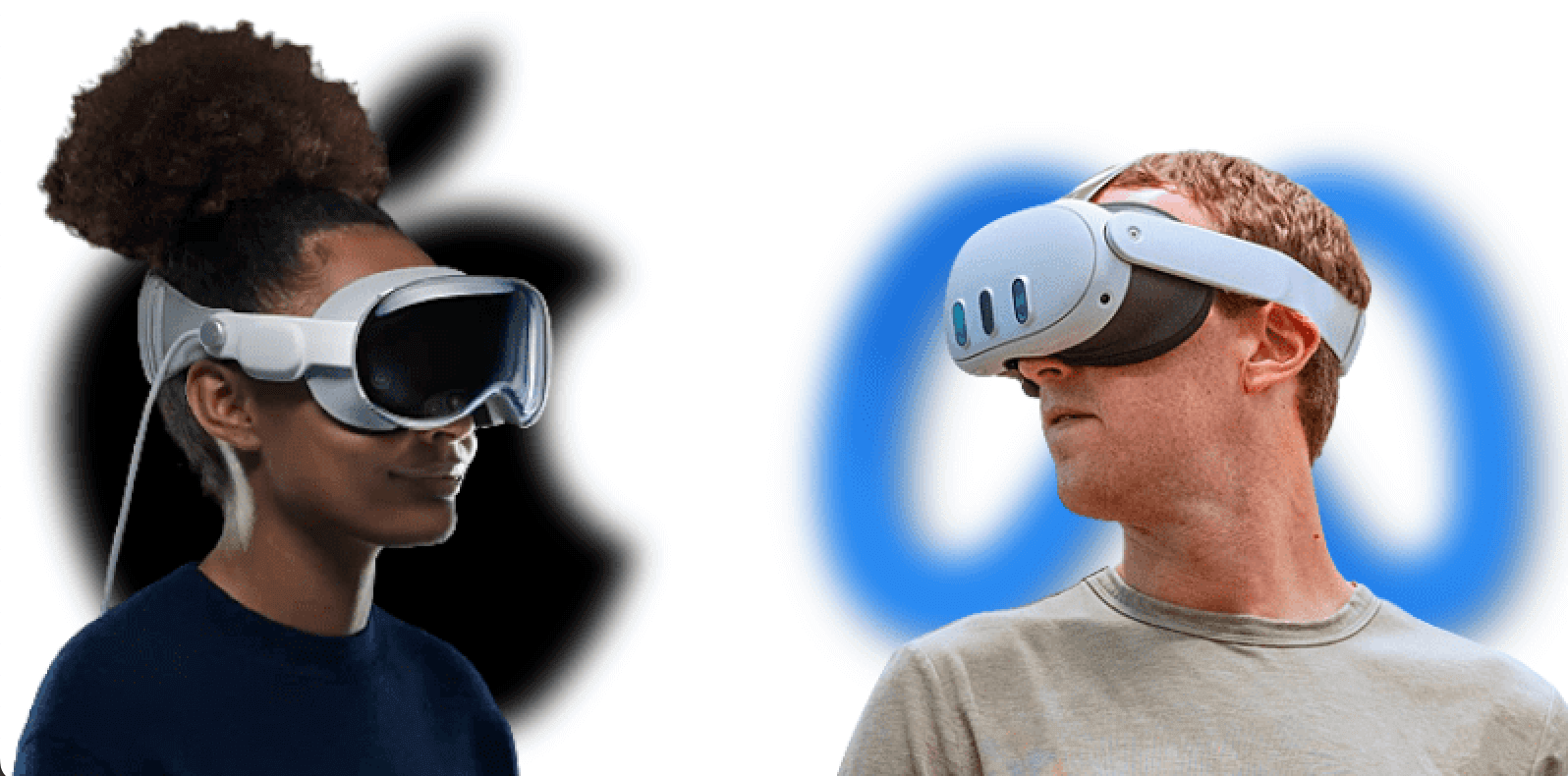Insights From The Blog
Apple Vision Pro vs Meta Quest 3: What Do You Get When You Pay Seven Times More for Your VR/MR Tech?
Here at Unity Developers, it’s not often that we do a head-to-head on tech because the devices we love and use are usually fairly unique and comparisons rarely mean much. However, the recently launched Apple Vision Pro is not too dissimilar for the significantly less expensive Meta Quest 3, and we thought that it would be worth putting them side by side and seeing which one gives you the most for your money. Let’s look at the contenders;
Meta Quest 3. New immersive experiences are yours to enjoy with the state-of-the-art Meta Quest 3 headgear, which combines virtual and real-world elements in a revolutionary way. With Meta Quest 3, you may become anything you choose, from a piano player without breaking the bank to a concert goer without leaving your couch. Meta Quest 3, the world’s best-selling VR/AR experience, is a giant leap forward for the company thanks to its innovative use of mixed reality and augmented reality technologies. You can currently pick up a new Meta Quest 3 for around £459 for a 128Gb storage version or £620 for the 512Gb version.
Apple Vision Pro. You can use your eyes and voice as well as your hand to navigate with the impressive Apple Vision Pro, which is being hailed as the world’s first true spatial computer that integrates digital material and apps into your real environment. With visionOS, the first spatial operating system ever developed, users of Vision Pro may experience digital content as if it were physically present in their environment. To make sure that everything seems like it’s happening right before the user’s eyes in real time, the innovative architecture of Vision Pro incorporates a dual-chip design with custom Apple silicon and an ultra-high-resolution display system that packs 23 million pixels across two screens. You can currently pay anything from £2,800 to £4,900 for an Apple Vision Pro, depending upon the internal storage size and where you get it from.
What’s the difference?
Processing power.
Plainly the Apple Vision Pro is significantly more expensive, but is it worth seven times more than its contender? Let’s have a look at some of the major specifications.
The Apple system has a micro-OLED display with 23-million pixels and refresh rates of between 90 and 100Hz. It has an 8‑core CPU with 4 performance cores and 4 efficiency cores, and 16Gb of unified memory to use. The system also has Two high‑resolution main cameras, six world‑facing tracking cameras, four eye‑tracking cameras and a LiDAR Scanner. The unit weighs around 650 grams in standard form.
The Meta Quest 3 has a 4k Infinity display that develops 2064 x 2208 pixels per eye and uses the Qualcomm Snapdragon XR2 Gen 2 processor with 8Gb of RAM. With an impressive 30% increase in resolution compared to its previous version, this device provides a maximum resolution of 4,128 by 2,208 pixels and a refresh rate of 120Hz. Although it offers high-fidelity colour passthrough for mixed reality experiences, it does not have the eye-tracking technology found in the Meta Quest Pro. The Quest 3 is equipped with the Qualcomm Snapdragon XR2 Gen 2 chipset, providing a graphical performance that is twice as powerful as that of the old Quest 2. Thanks to this powerful CPU, virtual reality players may anticipate seamless and uninterrupted experiences.
On paper there is undeniably quite a gap between these two headsets, but does that mean that you get so much more “bang for your buck” with the Apple device? In terms of specifications, the screens of the Apple Vision Pro far surpass those of the Meta Quest 3. However, the Meta Quest 3 outperforms the Apple Vision Pro in terms of field of view. The Quest 3 has a field of view of 110 degrees, but the Apple Vision Pro is expected to offer a field of view of approximately 100 degrees. Some reviewers have noted the presence of black borders surrounding the image displayed within the headset. The field of view of the Meta Quest 3 is expansive and narrower compared to the Quest 2, thanks to the implementation of pancake lenses. However, when pressed against the face, it does not provide exceptionally sharp visuals.
Refresh rate.
The Meta Quest 3 has a greater range of options for the display changeable refresh rate, which is advantageous for gaming purposes. The device automatically switches between four different refresh rates: 72Hz, 80Hz, 90Hz, and 120Hz. In contrast, the Vision Pro only offers a variable refresh rate of 90Hz, 96Hz, and 100Hz. When all is said and done, the Apple Vision Pro offers a superior, more defined, and more vivid visual experience compared to the Meta Quest 3, but has a noticeably narrower field of view.
The audio experience is another area where they are pretty much aligned, and both systems offer a good level via the in-built speakers and are able to accept external units, so the sound quality can be a function of whatever earbuds or jacked ear units you have.
Camera Systems.
In terms of external cameras, the Quest 3 has six, but the Apple device is positively adorned with all manner of cameras and sensors including high-resolution front cameras, with which the device captures video and streams it directly into the headset. The rest of the setup includes six cameras for world-tracking, four cameras for eye-tracking, a TrueDepth camera, and a stereoscopic 3D camera for capturing spatial films. The Apple device is also equipped with a LiDAR scanner, four inertial measurement units (IMUs) to determine its orientation in a three-dimensional space, a flicker sensor, and an ambient light sensor.
The Vision Pro’s abundance of sensors and cameras makes it hard for the Meta Quest 3 to hold its own. The Vision Pro allows you to control the amount of see-through from the cameras, but the Meta Quest 3 only allows the user to go full passthrough or virtual reality.
Peripherals.
Outside of main computing and visual systems, there are also comparisons. The battery life of each device is very similar. As far as the Vision Pro’s battery life is concerned, Apple claims two hours of regular use and around two and a half hours of video playback time. The Vision Pro can also be used for long periods of time when connected to a wall outlet. One charge will get you two hours of playtime on the Meta Quest 3. It’s entirely self-contained, with no cord or other power source whatsoever, thanks to its built-in battery pack. For use beyond the recommended two to three hours, you can charge the gadget by connecting it to an electrical outlet and continuing to use it throughout that time.
The most inconvenient aspect of the Vision Pro is that, instead of having an internal battery, it employs an external battery pack that looks ridiculous. The weight of the smartphone is a common gripe among consumers, and it’s simple to understand why. Whether it’s connected to the wall or the external battery pack, the headset will always have a cord hanging from it. Apple definitely ought to have resolved this issue considering the pricing of their device.
Conclusion.
This is not quite as clear-cut as you might think. More processing power, improved displays and graphics, enhanced capabilities, a more premium design, and a more unified user interface are all features that define the Vision Pro. However, there are some areas in which the Apple device is only comparable to or even lacking in comparison to the Meta Quest 3. It’s important to understand what these headsets actually are in their own right. The Meta Quest 3 is solidly a gaming device first and foremost; the Vision Pro is more of an all-round product.
Because of the purpose for which it is intended to be used, the Vision Pro has been built with more processing power, improved displays and graphics, enhanced capabilities, a more premium design, and a user interface that is more professional. Even though it is not as powerful, as good-looking, or as sharp as its predecessor, the Meta Quest 3 is nonetheless a very capable VR headset. At the moment, it is the most powerful virtual reality device that can hold its own. In addition to being quick, the Quest Store offers a wide variety of games and experiences to choose from. Not only does it have a wider field of view than the Apple Vision Pro, but it also does not require you to be permanently connected to an extra power pack in order to perform.
So, back to the fundamental question; is the Apple Vision Pro worth seven times the cost of the Meta Quest 3? No, probably not…three times, yes, but seven times, no.

